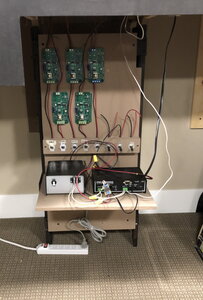Thanks for the reply, however I am a little puzzled by your response. This is the first DCC layout I am going to wire up. Most articles I read have all suggested blocking track into districts. I never understood why you would block sections in the first place unless it was a reverse loop or some operational necessity? If I understand DCC correctly, information is sent to a specific loco rather than the track and that message will be received by the said loco no matter where it is regardless if other locos are occupying the same track. That's what I understand is the advantage of DCC. Whereas DC works on the principle of sending power to the track and whatever is occupying that track will operate at the same time causing problems which is why blocking is necessary!
So your answer makes sense to me but it seems to go against what most are saying. Sorry if I sound little confused.
Sorry if my post caused any confusion. A smaller or even a medium sized layout doesn't require power districts or circuit breakers or
blocking.
I was well on my way into wiring my modest sized DCC layout in a 16 x 12 room before I even knew much about districts, circuit breakers and the other requirements of a larger DCC layout. I have a centrally located Command Booster location and the DCC buss runs in two directions from the Command/Booster, no districts of any kind, no circuit breakers or additional Boosters on my layout.
Using blocking on a DCC can take several forms that include of which you have read about:
- Blocking sections of a yard to turn of power being routed to standing locomotives.
- Blocking of a layout for power districts.
- Blocking for the use of circuit breakers.
- Blocking for signals.
- And blocking for a reverse loop, if your layout has one.
- Blocking for combining DC and DCC on a single layout.
- Blocking for DC layouts and Cab control.
Using the term blocking when referring to feeders is confusing to those new to DCC. I think for DCC users using the term "Sectionalizing" would be a better term than blocking and leave blocking to DC users. Feeders are installed to lengths of track between rail joiners and are connected directly from the buss to the track. On a simple DCC layout the buss feeds all the track via many feeders without the need for any electrical switches. A simple loop of track could and would operation with one or maybe two sets of feeders
The purpose of a feeder is to supply the power and DCC signal to sections of track and not worry about a loose rail joiner (or the diverting side of a turnout) that would interfere with the power transfer and DCC signals and secondly help reduce power drop along the rails in long sections of track on a larger layout. Its recommend to solder each rail joiner.
Take a look at "Wiring for DCC"on the internet.
DCC helps keep every thing simple.
Hope this helps.
Greg
######################
wiringfordcc.com


